When it comes to pufferfish, most people only think about the many different saltwater species.
However, you may not know that there are tons of beautiful freshwater pufferfish available to keep in your aquarium that are equally as unique and challenging as their saltwater counterparts!
Pufferfish are known for their distinctive appearance and their even more unique behavior, especially when they are feeling threatened.
They will typically inflate to a much larger and rounder size when a predator approaches them and also contain a venom named tetrodotoxin, which is extremely dangerous.
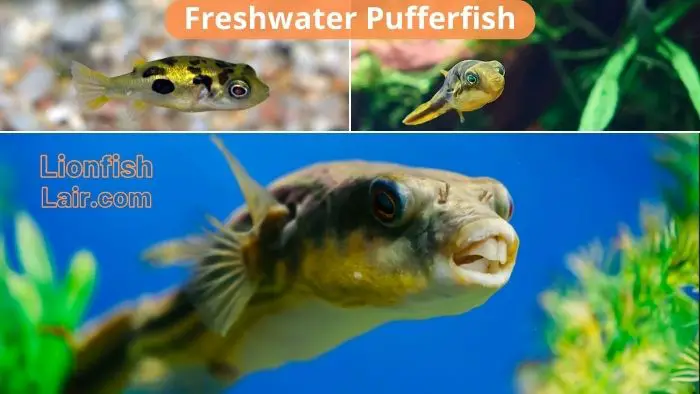
Due to these unique characteristics and the fact that they require very good water quality as well as a lot of space, freshwater pufferfish are not that easy to care for.
I would recommend pufferfish to hobbyists that have more experience, especially with managing large tanks, and wish to challenge themselves with this unique species.
They might be difficult to care for, but as most of you know with higher care level fish – the rewards are massive!
In this guide we will not only be looking at each of the freshwater pufferfish available to freshwater fish keepers, but their requirements, behavior, compatibility, and much more.
Freshwater Pufferfish List
Due to each freshwater pufferfish having their own characteristics and tank requirements, instead of giving you a general overview of all the different subspecies, you will be provided with the individual requirements and specific information regarding each subspecies.
Something important to note before diving into the list is that you probably will be wanting to avoid tank mates for your puffer fish.
I say this because the freshwater species that feature on my list are all pretty aggressive fish and have bad tempers paired with incredibly big teeth – not a good combination!
Make sure you avoid community tanks with your puffers and avoid any slow-moving, smaller fish as they might not survive too long. All in all, puffer fish are better off alone than with tank mates, especially other puffer fish!
Now, let’s dive in to the list!
Dwarf Puffer Fish
The dwarf puffer fish (Carinotetraodon travancoricus) is one of the most popular freshwater pufferfish, and they actually do not require as much experience and overall maintenance as the other puffers that are featured here.
This is due to their incredibly small size, only growing to a maximum length of 1.4 inches (3.5 cm), and the fact that they do not have endlessly growing teeth either.
This enables you to get away with housing them in a smaller tank compared to some others on my list.
Dwarf pufferfish sport bright coloration, a yellow/green body paired with some interesting black spots, their eyes are large in comparison to their bodies, which can be rather amusing.
You can easily keep one dwarf puffer alone in a small tank, a 10 gallon freshwater tank (45.5 Liters) is perfect for them as they can still be fairly territorial and aggressive, which requires them having their own space.
For a graphical representation of their various requirements, take a look at the image below that I created:

If you wish to keep them with other fish, do so, but ensure that your tank is large enough for them to establish a clear territory away from other inhabitants.
I would suggest a 20 gallon (75.7 liters) tank as the minimum size should you wish to keep them with other freshwater fish.
They are carnivores that require small, meat-based foods, but try and balance it out and feed them a good variety of different foods. Such as frozen bloodworms and brine shrimp, with the addition of live foods like blackworms or snails.
Feeding them live food will stimulate them and bring out their natural hunting instinct that can be difficult to replicate outside of the wild.
Dwarf puffers, or pea puffers, require a tropical freshwater temperature ranging between 74°F and 82°F (23.3°C – 27.7°C) to live comfortably.
Fahaka Puffer Fish
Now, let’s go from the smallest freshwater pufferfish breed to one of the largest - the Fahaka puffer fish (Tetraodon lineatus) is certainly one of the biggest puffers you can keep, growing to an incredible 16 inches (40.64 cm).
Due to this, they will need a pretty large tank – I suggest 150 gallons (570 liters) as a minimum. This gives them plenty of space to move around in and grow to their max size without you having to increase the size of your tank.
Regarding their aquarium environment – they will need plenty of plants and vegetation, as well as powerful water filters to ensure the water quality is good enough for them as they are very sensitive to poor water quality.
The graphic I created below showcases all of the specific information and requirements for the Fahaka Puffer Fish:
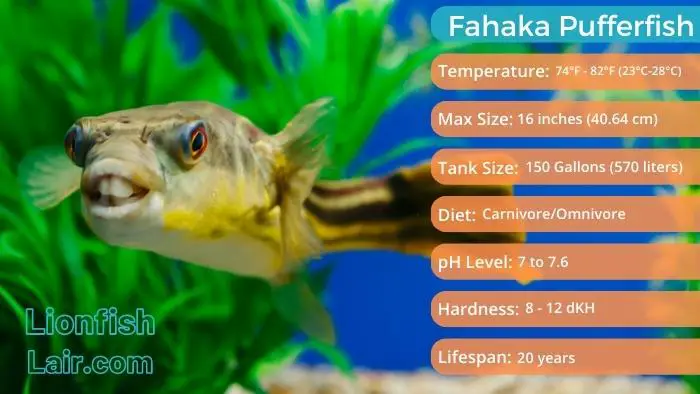
Unlike the dwarf puffer fish, these guys are almost always aggressive and mean fish. They can even be pretty aggressive toward their human owners, with their incredibly sharp and human-like teeth seemingly never stopping to grow. Be careful when feeding one as it could be goodbye to your fingers!
This leads us on to look at their diet. They are carnivores, but interestingly enough are referred to as molluscivorous, which means that they typically eat oysters, krill, cockles, and mussels rather than other fish.
In terms of their appearance, it is unusual to say the least. They showcase bright orange/red eyes and are covered with short spines across their bodies.
Their bodies are gray/brown in color with a lighter shade on their bellies extending from their pectoral fins to their tails.
Congo Pufferfish
Congo pufferfish (Tetraodon miurus) do not leave much to the imagination regarding their origin, they typically reside in African rivers and they like to bury themselves in sand to hide away from predators.
Unlike the other two puffer fish mentioned, the Congo puffer is medium/small in size, reaching a maximum of 3.9 inches (10 cm) in length.
They adapt pretty well to most environments and are not as aggressive as their Fahaka cousins. 40 gallons is the perfect size tank for them (151.4 liters) to feel both free and comfortable in.
Also, they are fairly mild-mannered for pufferfish too, typically getting along well with other fish of a similar size and nature.
If you wish to know their requirements in a detailed and graphical format, then take a look at the graphic I created of the Congo puffer fish overview below:
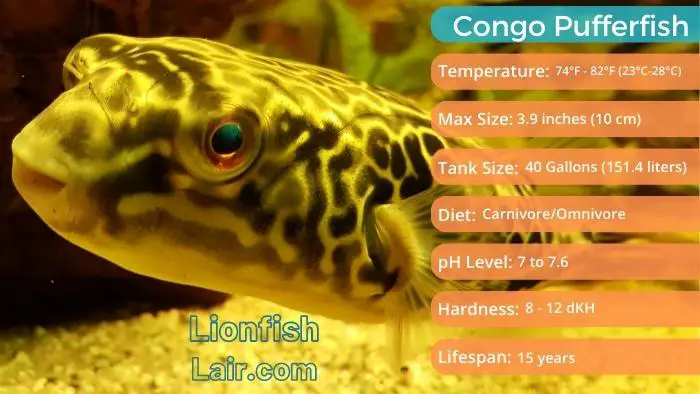
Overall, they are pretty peaceful, especially for puffers, but you still need to add tank mates with caution. Do not keep them with tons of different fish, and if you do plan on building a community around them, then I would strongly suggest keeping them in a 70 gallon (318.22 liters) tank or larger.
Other Freshwater Pufferfish
We have now covered the most popular and common freshwater puffers amongst hobbyists, but there are a few more subspecies to mention:
- Golden Puffer (Auriglobus modestus)
- Red-Tailed Dwarf Puffer Fish (Carinotetraodon irrubesco)
- Congo Puffer Fish (Tetraodon miurus)
- MBU Puffer Fish (Tetraodon mbu)
- Imitator Pufferfish (Carinotetraodon imitator)
- Crested Pufferfish (Carinotetraodon lorteti)
- South American Puffer Fish (Colomesus asellus)
- Ocellated Puffer Fish (Leiodon cutcutia)
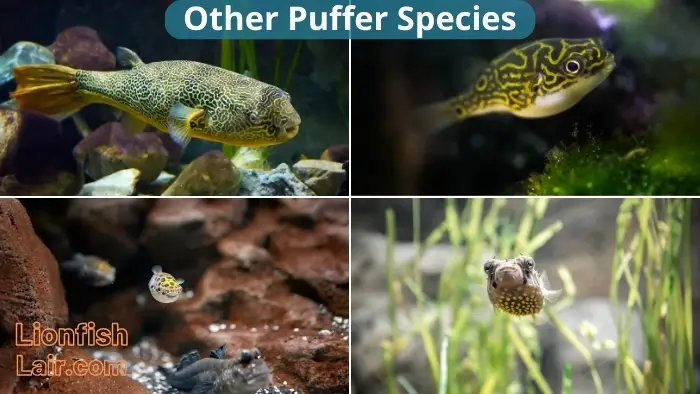
These puffers are not as popular among hobbyists as the previously mentioned ones. However, they certainly are found in home aquariums and good options for advanced hobbyists.
How to Care for Freshwater Aquarium Pufferfish
Now that we have covered the most popular freshwater pufferfish species, it makes sense to learn how to keep them happy and healthy in a home aquarium environment.
The first thing you must try and do is set up their aquarium similar to their natural habitat in the wild, you will achieve this by following the steps provided in this guide.
Tank Size and Aquarium Requirements
The tank size for your freshwater puffer fish will depend on the actual size of the subspecies you plan on keeping.
A dwarf, red-tailed dwarf, or an imitator pufferfish will all require the smallest size tank, which is 10 gallons (45.46 liters) at a minimum.
Whereas the more medium sized puffers such as South American, or Congo puffer fish will need a 40 gallon (151.4 liters) aquarium at the very least.
Additionally, crest pufferfish will need a 55 gallon (250 liter) tank at a minimum.
Now for the big puffers – the golden puffer is going to need a pretty sizable tank – 125 gallons (568.26 liters) at a minimum, and the MBU puffer fish needs a minimum tank size of 500 gallons (2273 liters).
This is another strong indication as to why you need to be an advanced freshwater fish keeper to keep the larger sized puffers! You also need a pretty healthy budget if you are going to get a 500 gallon or larger aquarium.
With all types of freshwater fish, not just puffers, it is always good to keep them in a tank larger than their minimum requirement. This allows them to have more space and freedom, and puffers certainly require an abundance of both.
Water requirements
Their water requirements are fairly simple, but the key is to always make sure that you are hitting these requirements on a consistent basis to keep your puffer as healthy as possible.
So, you will need to keep a pH level between 7 and 7.6. In terms of water hardness, you need to keep it between 8 and 12 dGH, and the water flow needs to remain low and constant.
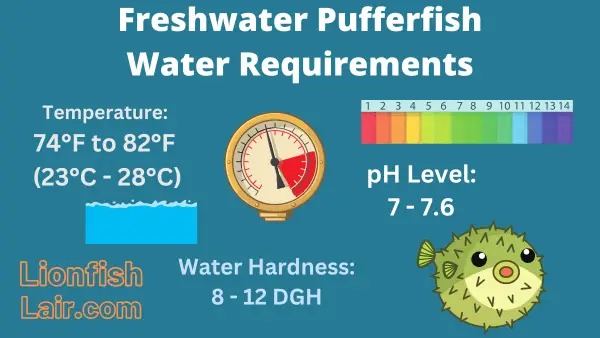
As for their water temperature, they will need between 74°F and 82°F (23.3°C – 27.7°C) to live a healthy and comfortable life.
Freshwater Pufferfish Food and Diet
Feeding your pufferfish is something incredibly important but that people often get wrong. They require a balanced diet to live a happy and healthy life.
Yes, most of the freshwater pufferfish mentioned prefer eating meat-based foods, however, they are technically omnivores and do require some vegetable-based foods to achieve a balanced diet.
A balanced diet is pivotal in the overall health and well-being of your fish, and if they are healthy and fed correctly, they will usually become even more bright and colorful.
So, for their diet they will need invertebrates primarily, as most freshwater puffers prefer this type of food the most in the wild.
Snails, shellfish, and crustaceans should be fed to them regularly, with the addition of live and frozen meaty foods such as bloodworms and you can even feed them small feeder fish too.
You will also want to include vegetable-based foods like pellets and flakes and then you will have achieved a balanced diet for your puffer.
They also eat algae too, but you shouldn't rely on them to be one of your top freshwater algae eaters as they need far more than that and will not clean your tank completely and regularly.
Be careful when feeding as they do have incredibly sharp teeth. This is why it is not a good idea to keep any pufferfish mentioned on my list apart from the dwarf variant with other fish, especially small ones as they will make short work of them due to their aggressive and territorial nature, as well as being naturally predatory fish.
The following graphic I created summarizes the best food to feed puffer fish.
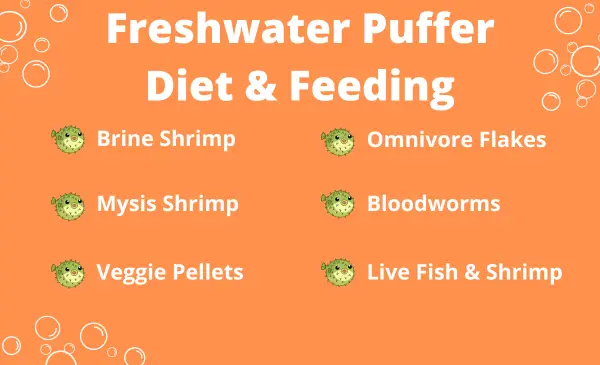
You should only feed your freshwater puffer fish between 1 and 2 times per day, and make sure that you clean out any excess food that can lead to poor water quality – remember, puffers need supremely good water quality to live healthily.
Replicating their Natural Habitat
As mentioned previously, it is important to try and replicate their natural environment so that they feel safe and comfortable and also get used to their new home as quickly as possible.
Their pH and water hardness need to be kept and maintained the same with no sudden shifts. Additionally, they need a small current in their water if possible as this recreates their natural home of rivers in South Asia, America, and Africa.
Freshwater puffer fish are prone to diseases and parasites, so you should invest in some powerful water filters for your aquarium, which will help keep the water clean, preventing unwanted bacteria, disease, and parasites.
General Freshwater Pufferfish Care
Due to pufferfish having teeth that continuously grow throughout their life, you will need to keep an eye on them as when they grow too long your puffer may struggle with eating.
If this is the case, then you should clip them yourself. This is typically an easy thing to do but just be careful as they are pretty dangerous fish, especially the larger species. However, once you have done this a few times, they will know what is going on and be more friendly about it!
Something else worth mentioning is that freshwater pufferfish are not the hardiest fish around, and they are pretty susceptible to ectoparasites, which usually come in through their skin, fins, and gills.
Fortunately, it is pretty easy to treat as if you see them in clear discomfort, upon closer inspection it is usually down to a parasite infestation. You can remove them manually or simply raise the temperature of your tank which usually kills them off.
Do so with caution, however, due to puffer fish’s sensitivity to temperature and water changes too.
Behavior and Tank Mate Compatibility
Unfortunately, you have probably learned by now that freshwater puffers are aggressive and territorial towards their own and other fish.
This does not bode well for keeping them with tank mates or even in a community tank! However, as mentioned above, the smaller “dwarf” subspecies of freshwater puffer fish can be kept with some other fish, as long as they are larger and have a peaceful temperament and similar tank setup requirements.
However, it is our suggestion and probably the best idea to simply keep them away from other fish in general. You do not want any accidents, nor do you want to cause unnecessary stress to any of your fish as that will only lead to bad things.
It is difficult for many to accept as many peoples dream aquarium would ideally be teeming with life, however, it is a sacrifice you have to make in order to keep the undeniably unique and awesome pufferfish.
Summarizing Freshwater Pufferfish
Keeping freshwater pufferfish is no easy task, it requires a lot of work and experience. However, it is one of the most rewarding fish species to keep, if you do so properly.
Their unique appearance and behavior make them super endearing. They are also very entertaining to watch go about their day.
I really hope that this guide has not only familiarized you with these incredible fish, but also taught you some valuable lessons on how to keep one healthy.

